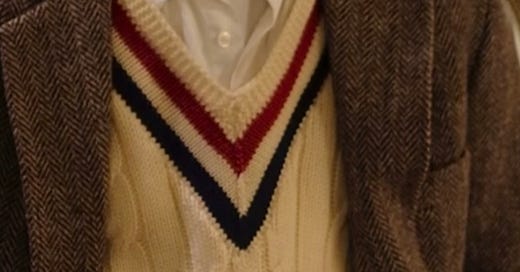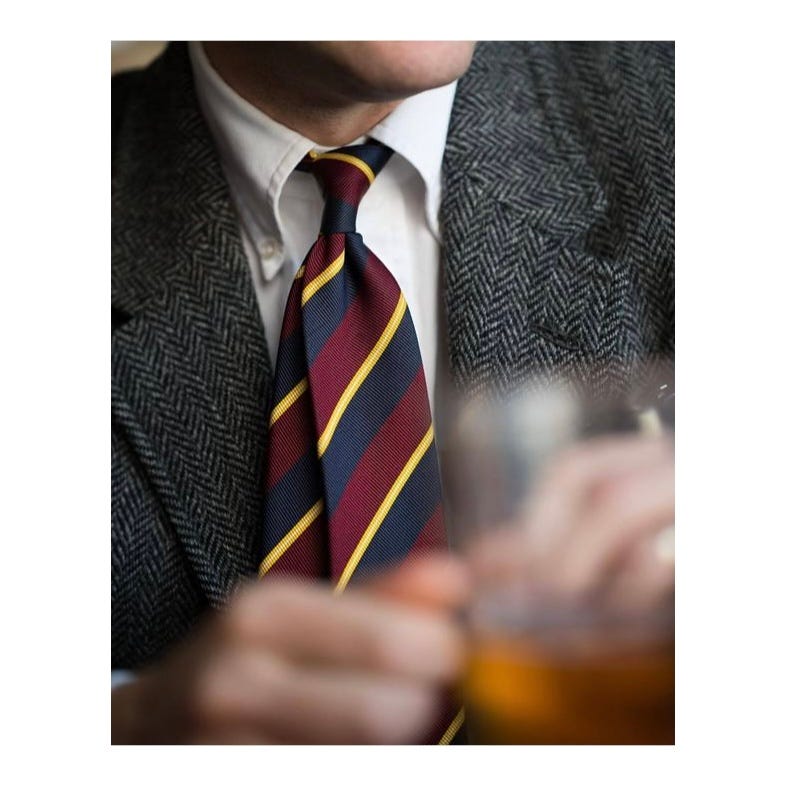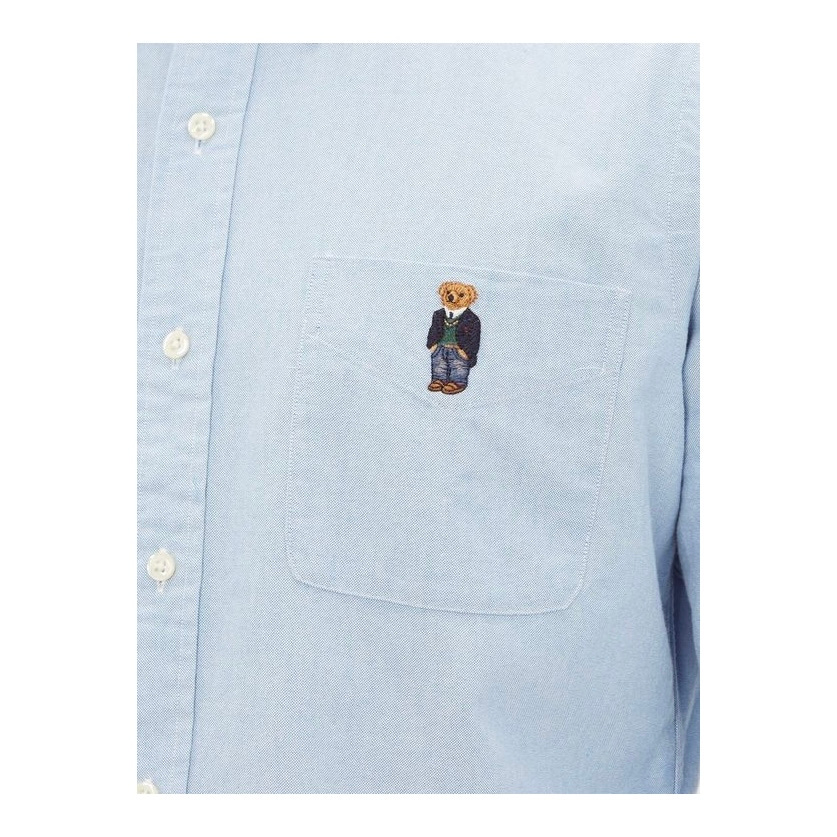I have to begin this meeting with a confession, I am only a very recent convert to the wearing of Oxford Cloth, Button-down shirts. You see, for several years I had not cared for the look of buttons on the collar, however, as I have journeyed farther into Ivy it became a style which I could not ignore. These days I’m all in on Oxfords, and have been steadily growing my collection. This meeting serves as a guide to purchasing OCBDs, developed in response to my personal voyage of discovery. I hope to, within the extent of my knowledge, cover all given facets which one might consider when buying a shirt; I hope too to analyse the manner in which these facets are presented on shirts from several brands. With consideration of my relative newness to the style, this is my quintessential OCBD guide.
Size and Fit
The most important points of interest when sizing an Oxford do not vary greatly from those of any other collared shirt, one point though is that, perhaps due to their casual nature, Oxfords are often sized small through large, rather than by collar size, which can prove problematic when trying to get the right fit. So, points to look for particularly are collar, sleeve, length of the garment. No surprises there.
When it comes to fit, for me I think it has to be roomy, the drape of Oxford cloth lends itself wonderfully to luscious ballooning of the shirt along the length of the back. Especially when tucked in, additional volume in the garment allows for the construction of a soft, slouchy, timeless silhouette. Consideration when selecting fit should be given to the function of an OCBD, as a casual shirt, I would suggest that, as such, one should be, and look to be, comfortable in one. I wouldn't shy away even from the most generous cuts, such as the J. Crew giant fit, in order to achieve this, but opting for classic fits at the very least ought to deliver nicely.
An Eye for Detail
Due to their ubiquity and age, Oxfords have been the subject of iteration, innovation, and experimentation over the years. The result of this is a number of pointed details which make for notable variation between garments, I have grouped those which make the greatest difference together below:
Collar - Arguably the most important, the collar is the most immediately noticeable point of variation between any two Oxfords. Traditionally, OCBD wearers have coveted the “collar roll”, that is to say the manner in which the collar rolls like an ocean wave, as a result of it being fastened at the point by the button. If this is the look one wishes to have from their shirt, then they ought to know that a larger collar will make this far more pronounced, anything in excess of 3” measured from neck to point will provide well, though the bigger the better. That said, there is also a separate and subversive look that can be had from going for the opposite, especially when worn with a skinny tie, this look is much more modern and can pair nicely with sportier wear, Aime Leon Dore presents some good examples of this style. The subversive nature of the small collar can be nice to get away from an overly proper look which the OCBD sometimes lends in its traditional form. It breaks away from those associations which perhaps can be said to perpetuate harmful stereotypes of who can and cannot wear an Oxford shirt. The point being, I do not think there is a right and wrong collar style, but that the collar on an Oxford functions to communicate a great deal, and consideration of this is necessary when purchasing one.
Stretch - I am not referring here to stretch fabrics, for which, as members likely know, we have no time here. But rather the additions that can be made to a garment which render stretch fabrics unnecessary. There are three styles of pleat which I have encountered in OCBDs, though others almost certainly exist. The first and most common is a box pleat, arguably a defining feature of the Oxford which in part lends it its desirable casual look. This style is my personal preference, and ties into my aforementioned feelings regarding fit, a box pleat adds to the pleasing drape of a more relaxed shirt, and the casual connotation exacerbates this care-free perception. The second, less common style is that of side or “knife” pleats, like those which might be found on a more formal English-collar shirt. These are likely to be perceived as more formal and it is for that reason that I would not personally opt for them, they somewhat defeat the point of the Oxford, they also provide less mobility than the box pleat. The third option is the absence of pleats, which I have found to be surprisingly common. Lack of pleats will seriously impact the mobility in an Oxford, again, personally I would skip over these in favour of the box pleat, though if one desires a particularly sleek look this could be an option. Ultimately, I would advocate for the seeking of an Oxford with box pleats, for the optimum drape and wearability.
Front Details - The presence or absence of a breast pocket is another point of distinction, their inclusion perhaps lends the perception of a sportier, or more casual appearance. Whilst it is unlikely that you’ll be keeping anything in it, the noticeable shift in appearance which a breast pocket lends shouldn’t be ignored, and may well be the detail which perfects a given shirt. In addition, or in replacement of, the breast pocket, there is also the consideration of embroidery, most obviously there may be the maker’s logo, but other details such as crests, mascots, characters, band logos, sports badges, can all be found. The Rowing Blazers x Grateful Dead Steely or vintage Looney Tunes shirts, for example. Embroidery, I think, is a particularly good source of both variety and whimsy in shirts, and another way in which they can be made to appear more or less formal. I’ll also include buttons here, oft overlooked perhaps, but consideration of the composition of buttons is warranted. Button style will have a particular effect on perceived formality.
Back Details - The locker loop is a minor detail which’s inclusion is largely esoteric. I would posit that these days very few Oxford wearers are likely to need to hang their shirts on a locker hook. However, it is a feature many find to be aesthetically pleasing, and which ties nicely to the history of the garment. It might just be the detail which completes the look of a shirt for the wearer. Notably they tend to be omitted from oxfords made by Polo Ralph Lauren, but are almost always present on Oxfords made by GANT, who were understood to be the progenitors of the feature, however in the past year evidence has come to light that it in fact originated among sailors due to limited space. The provenance of back buttons is less known, in fact there isn’t total consensus on what the point of them is, though there are some theories. They’re less common, and their limited provenance means they haven’t got quite the same romantic appeal as the locker loop, overall they are a pleasant affectation, but are unlikely to make or break a shirt.
Ditch the labels
I’ll let you into a secret, my favourite shirt isn't Ralph Lauren, it isn’t J. Crew, J. Press, Brooks Brothers, GANT, Kamakura or Drake’s. It’s from now-defunct, semi-bespoke Saville row tailor come department store shell brand: Chester Barrie. When I tell you this shirt is perfect, the perfect collar, box pleat, a locker loop, real mother of pearl buttons, resplendent in heavy white cotton. It cost me £5 in a charity shop, if you have information on the whereabouts of others, I wear a size S, bang my line.
Another of mine is from rugby-outfitter Canterbury, complete with a number of brilliant sporting-derived details.
Point being, getting off of the beaten brand track with Oxfords is a fun way to introduce some variety to your collection, especially if like myself you prefer to stick mostly to one or two colours. As mentioned, the Oxford’s classic, wardrobe-staple, nature leads brands to experiment with it, so seeking out Oxfords made by brands known for other garments can prove to be very worthwhile. It can also be gentler on the wallet.
With that said, here’s a breakdown…
Just a look at the OCBDs available from some labels known for their Ivy wear.
Brooks Brothers - The inventors of the Oxford, quality and fit of Brooks shirts depends greatly on era. Please refer to this earlier meeting for a more in depth look at buying vintage Brooks. As for modern options, lack of a relaxed fit option, and the proliferation of stretch fabrics, lead me to suggest other options when considering the price point. Vintage Brooks can be great, buying new probably isn’t worth it, especially considering the astounding quality available at a similar price point elsewhere in this list.
Drake’s - One of the most expensive offerings on this list, notably sized using collar measurements, great for achieving the perfect fit. Very much the quintessential classic Oxford, made in my home county in the UK, and with the expected appointments: classic collar, breast pocket, box pleat, locker loop, back button. Finding them second hand will be a challenge, and they retain value.
GANT - Credited with first putting the locker loop on a commercial Oxford, GANT has produced a wide variety of shirts within the style. They tend to have the aforementioned locker loop, and a back button, as well as the logo embroidered on the front, which I find to be a little invasive in its being bright red and blue. Attention should be paid to avoid the poly-cotton tech-prep line, as well as slim fits which have flooded the market over the past decade. Collars are not overly skinny, but neither do they quite meet the classic look. I’d look for deals on the second-hand market, but perhaps look to other labels mentioned in this list if one is considering parting with the considerable sums which one costs new.
J. Crew - Most notable currently for their wide selection of fit options, including the now-infamous giant fit. Unfortunately I haven't been able to sample these in person, but based on photographs and thoughts from others, I think it might well be worth a try, the relaxed also, is a nice option. Collar size is very much in the classic camp, which is nice, especially when paired with the retro fits offered. Whilst still expensive, J. Crew shirts are considerably more affordable than other entrants, especially domestically in the States, or on sale elsewhere. The used market is fairly saturated, though a lot of these come from the previous era of J. Crew, so attention to detail when purchasing is advised.
J. Press - Probably the best Made in USA option available, J. press sits with Brooks as an Ivy style bastion, and they’ve done arguably a much better of job of retaining that title. On the more expensive side, and tricky to obtain outside of the states, but the offerings are undeniably excellent. I am particularly fond of their flap-pocket option, and also the providing of varying sleeve lengths within their sizing. As for their import offerings, I’d opt for similarly named J. Crew at a better price and with more fit options.
John Simons - Classic, made in the UK, priced in line with most entrants on this list when new, for those on my side of the pond. Classic collar, breast pocket, box pleat, locker loop, back button, pretty much the perfect Oxford in my opinion. Sadly finding one second hand will be tricky, getting one new is tricky enough, and they keep their value far more than some of the offerings listed here, but if one can afford it, it is easily one of the best classic Oxfords on the market.
Kamakura (Ametora) - Named after the Japanese interpretation of Ivy style in the 1980s, Kamakura’s Ametora Oxford is a solid offering, sized with collar measurements which is especially useful when buying from Japan, as sizing tends to differ greatly with the West. However, this shirt is perhaps outclassed by the Vintage Ivy offering from the same makers, which exhibits more of the classic and romantic details which I have explained above.
Kamakura (Vintage Ivy) - A classic Oxford with the classic appointments, as exhibited by other offerings in this list: classic collar, breast pocket, box pleat, locker loop, back button, and cut in a traditional fit. As with most more specialist options, especially imports, finding used examples will be tricky, a fine option for those fortunate enough to find them or afford them though.
Ralph Lauren (Polo) - A very long history here, the vast majority of those available second hand tend to be slim or custom fit, the classic is going to be best here for the classic look, believe it or not. Personally I have a soft spot for Polo Bear Embroidery, I find it to be very charming. Polo is pretty sure-fire, though, as long as attention is paid to fit when buying, simple and classic. I’d definitely look towards second hand though, the deals that can be had are unignorable when compared to buying new, and at their price point there are perhaps better options to look towards.
Ralph Lauren (Chaps) - It’s important to look for older garments with Chaps, pay attention to where a piece is made, doing so will net in a piece that is both higher in quality of composition and more generous in cut. I think a vintage Chaps is a better option than the Rugby University Oxford, if one is looking for RL without the horse. Chaps Oxfords can be found quite commonly with breast pockets and locker loops, which isn't the case so much for Polo, so there’s cause to seek them out. Chaps shirts share the same soft collar present on Polo Oxfords, and mine at the very least has a pleasant collar roll, despite a smaller collar size.
Ralph Lauren (Rugby) - Rugby’s University Oxfords go further into the classic prep/ivy look, those familiar with Rugby will know their excessive brand of Neo-prep which they repped whilst they existed. Embellished with patterned collar bands and tongue-in-cheek embroidery, they speak to a very youthful expression of the OCBD. I’m yet to have come across one in person, but consensus is that they are cut quite slim, so they’re unlikely to provide the drape which I advocate for. Overall I think there are better options.
To round up, for those able to meet the prices, John Simons, Kamakura, and Drake's come out as the best for a classic Oxford. For those on a budget I’d look to buy second hand from Polo, GANT, J. Crew, and Brooks, and also to explore some more obscure brands, as mentioned above. Perhaps somewhat alarmingly, it seems that the Brits and Japanese are doing a better job currently at producing Ivy shirts than the yanks, just something I thought was a point of intrigue. As I have said, one should not be afraid to be adventurous with brand choice for Oxfords, so long as they have a good sense of the details which they are looking for, label is not important at all.
Oxfords are a staple of most good Ivy wardrobes, the manner in which they tow the line between formal, casual, and sporting can perhaps be seen as representative of the very point of this style. I sincerely hope I’ve been able to provide some insight today as a result of my personal research into this garment as I set about building a collection. If you have further insight I'd greatly appreciate you sharing it.
Thank you kindly for your attendance today, please invite others to join the club if you feel they’d be interested, and I’ll see you in a couple weeks.










As an experiment I just picked up a Uniqlo version OCBD and would rate the quality as equal to if not superior to JCrew.
Great list; I’m a sucker for the generous collar, locker loop, back button in the collar and pocket. I got a beautiful ‘Miles’ green one recently from Jake’s in London.